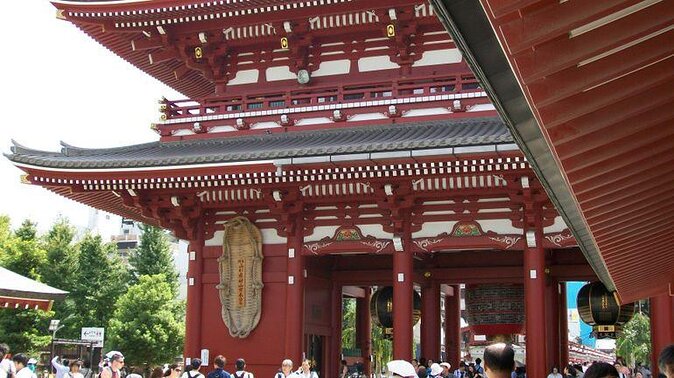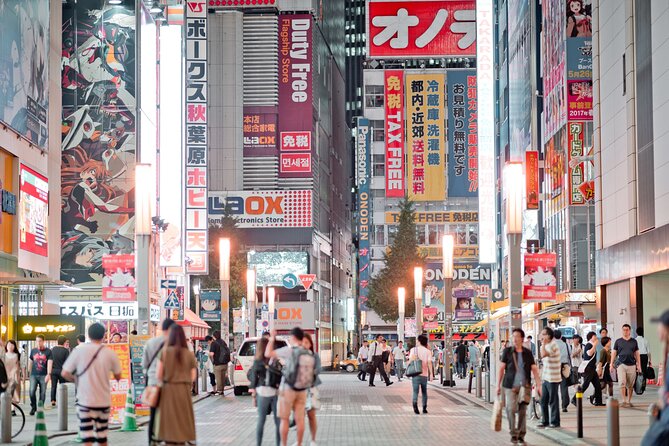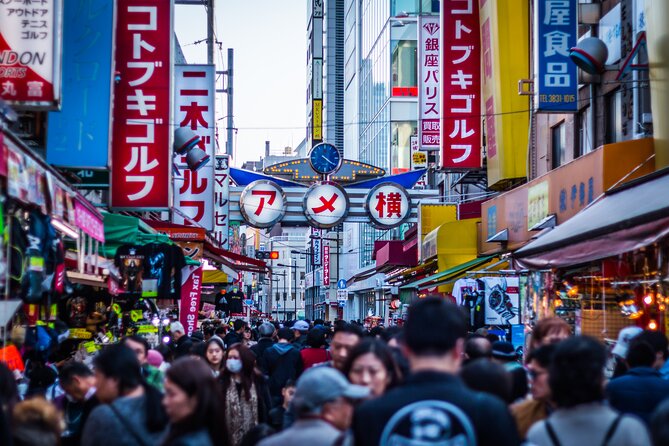Asakusa, one of Tokyo’s most vibrant and historically significant districts, offers a captivating blend of ancient temples, serene gardens, and modern pop culture. This immersive tour guides visitors through the area’s rich tapestry, revealing its remarkable transformation from a center of traditional Japanese life to a hub of contemporary urban creativity. Led by knowledgeable local guides, the experience promises an intimate and personalized exploration of must-see attractions, including the iconic Sensoji Temple and the bustling Nakamise Shopping Street. Whether you’re a history buff, a nature enthusiast, or a fan of pop culture, this tour provides a compelling glimpse into the unique character of Asakusa.
Key Points

- This guided tour provides an immersive experience exploring the history, culture, and atmosphere of Asakusa, a historic district in Tokyo.
- The tour covers must-see attractions like the Sensoji Temple, Nakamise Shopping Street, and other temples and gardens.
- Knowledgeable local guides lead the tour and offer insightful commentary on the sites visited.
- The tour includes all standard costs, such as admissions and local train rides, as well as complimentary food and drinks.
- The tour has a maximum of 8 travelers, ensuring a personalized and intimate experience.
Tour Overview

The tour, titled ‘From Asakusa: Old Tokyo, Temples, Gardens and Pop Culture’, provides an immersive experience exploring the history, culture, and vibrant atmosphere of Asakusa, one of Tokyo’s most iconic neighborhoods.
Led by local guides, the 13-reviewed tour takes visitors on a journey through ancient temples, serene gardens, and the lively pop culture scene.
Covering a range of experiences, the tour includes stops at must-see attractions like the famous Sensoji Temple and Nakamise Shopping Street.
With a maximum of 8 travelers, the tour offers an intimate, personalized experience.
Catering to various fitness levels, the moderate-intensity tour is accessible to a wide range of visitors, making it a great way to discover the charm of Old Tokyo.
You can also read our reviews of more tours and experiences in Asakusa.
Tour Details
This tour package includes all standard costs, such as admissions and local train rides, as well as complimentary food and drinks for participants.
The meeting point is in front of the iconic Kamiya bar in Asakusa, and the tour returns to the same location at the end.
With a maximum group size of 8 travelers, the experience provides an intimate, personalized exploration of the area.
The tour is wheelchair and stroller accessible, and it’s situated near public transportation, making it convenient for a wide range of visitors.
A moderate level of physical fitness is required to fully participate in the activities.
The detailed inclusions and meeting information ensure a seamless and enjoyable experience for those exploring Old Tokyo, its temples, gardens, and pop culture.
Inclusions

Included in the tour package are all standard costs, such as admissions and local train rides, along with complimentary food and drinks for participants. This ensures a worry-free experience as you explore the historical and cultural sights of Asakusa.
The tour package includes:
- Entrance fees to renowned temples and gardens
- Rides on local trains to navigate the city efficiently
- Delectable Japanese snacks and beverages to sample during the tour
- Knowledgeable guide to provide insightful commentary on the attractions
- All necessary transportation within the tour itinerary
With these inclusions, you can learn about the rich heritage and vibrant pop culture of Asakusa without having to worry about additional expenses.
Meeting and Pickup

Travelers meet the guide in front of the iconic Kamiya bar located in the heart of Asakusa, Tokyo’s historic district.
This lively meeting point allows easy access to the tour, which begins promptly at the scheduled time.
From here, the group will set out to explore the sights and sounds of old Tokyo, from ancient temples to lively pop culture hubs.
The meeting spot is conveniently situated near public transportation, making it easy for participants to arrive.
With clear instructions provided at the time of booking, travelers can feel confident in finding the starting location and joining the tour without any hassle.
The tour’s central meeting point ensures a seamless and efficient start to this immersive exploration of Tokyo’s rich heritage and modern allure.
Cancellation Policy
Customers can freely cancel their tour booking up to 24 hours before the experience begins, without incurring any penalties. This flexible cancellation policy provides peace of mind and allows for last-minute changes in plans.
No fees or charges for cancellations made up to 24 hours prior to the tour. Refunds will be processed promptly upon cancellation.
Cancellations after the 24-hour window are subject to a non-refundable fee.
Customers are encouraged to review the policy carefully before booking. The tour operator aims to accommodate customer needs and provide a hassle-free experience.
Group Size

The tour has a maximum of 8 travelers, ensuring an intimate and personalized experience. This small group size allows the guide to cater to the individual needs and interests of each participant.
It also enables the group to navigate through the bustling streets of Asakusa and explore the sights more easily, without feeling overwhelmed by large crowds.
With a maximum of 8 travelers, the tour maintains a relaxed and flexible pace, allowing guests to fully enjoy the cultural and historical significance of the area.
This intimate group setting fosters camaraderie and shared discovery, creating a memorable and enjoyable tour for all.
Physical Fitness Level
A moderate physical fitness level is required to fully enjoy this tour, as it involves navigating through the busy streets of Asakusa and exploring various historical sites on foot.
While the tour is designed to be accessible for most visitors, a moderate level of stamina and mobility is recommended.
Frequent walking between locations, potentially over uneven terrain.
Standing for extended periods during temple and shrine visits.
Occasional flights of stairs or ramps at some sites.
Navigating crowded areas and public transportation.
Maintaining a steady pace with the group throughout the day.
Travelers should be prepared for an active day of sightseeing and culture in the heart of old Tokyo.
Transportation and Accessibility

Along With the moderate physical fitness requirement, the tour’s transportation and accessibility features cater to a wide range of visitors.
The meeting point is located right in front of the iconic Kamiya bar in Asakusa, making it easily accessible via public transportation. The tour is wheelchair and stroller accessible, ensuring that guests with mobility challenges can fully participate.
On top of that, the tour returns to the same meeting point, providing a convenient starting and ending point for the experience.
With its proximity to public transit and accommodations for those with special needs, this tour in Asakusa offers an inclusive and accessible opportunity to explore the historic district and its cultural treasures.
Frequently Asked Questions
What Types of Temples and Shrines Will We Visit?
The tour will visit historic Buddhist temples and Shinto shrines, giving travelers an immersive experience of Tokyo’s rich religious heritage. Visitors can expect to see ornate architecture, serene gardens, and learn about the significance of these important spiritual sites.
How Much Free Time Is Allotted for Exploring Asakusa?
The tour provides ample free time for exploring Asakusa, allowing travelers to enjoy the district’s historic temples, shrines, and vibrant pop culture at their own pace. The exact duration of free time is not specified, but it’s a key component of the experience.
What Are the Main Highlights of the Pop Culture Aspect?
This tour showcases Tokyo’s vibrant pop culture scene. Guests can enjoy the iconic Akihabara electronics district, exploring anime shops, maid cafes, and quirky arcades that embody Japan’s cutting-edge otaku culture and digital entertainment.
Is There an Option to Extend or Customize the Tour?
The tour operator doesn’t offer options to extend or customize the tour. However, travelers can discuss any special requests with the guide, who may be able to accommodate them if feasible and time allows. Flexibility is limited within the set itinerary.
Can We Take Photographs Inside the Temples and Shrines?
Visitors are generally allowed to take photographs inside most temples and shrines, but should be respectful and avoid disrupting ceremonies or rituals. Some locations may have restrictions, so it’s best to check with the tour guide or staff beforehand.
Recap
This tour through Asakusa provides an immersive experience, showcasing the neighborhood’s rich history, captivating culture, and vibrant pop scene.
Whether you’re admiring iconic temples, strolling through serene gardens, or exploring the lively shopping district, you’re sure to leave with a deeper appreciation for this unique corner of Tokyo.
With knowledgeable local guides, inclusive pricing, and a small group size, it’s an accessible and personalized way to discover the heart of old Tokyo.
More Tour Reviews in Asakusa
- Rent a Bike in Asakusa and Enjoy Sightseeing in Tokyo!
- Tokyo Twilight Expedition Car Tour – Nighttime City Cruise!
- Unguided Cycling Tours in Tokyo
- Private Tour With Local Japanese Female Guide
- Guided Sake Flight in Asakusa Up to 10 Kinds of Sake
- 1 Day Tokyo Private Bus Tours + License Guide + Sweets Matcha Set
Not for you? Here's more things to do in Asakusa we have recnetly reviewed
- 2 Best Guided Tours In Asakusa
- 2 Best Private Car With Driver Services In Asakusa
- Private Sake Pairing@Ancient Underground
- [60 Minutes] Rickshaw Tour Around Asakusa [Complete Asakusa Tour/Power Spots]
- Tokyo Night Out
- From Tokyo: Mt Fuji and Hakone Private Day Trip
- Kimono and Matcha Experience in Asakusa Tokyo
- Japanese Tea Ceremony and Kimono Experience in Tokyo Hanayaka
- Nikko World Heritage Full Day Trip
- Tokyo: English Standup Comedy Night
- Private Tour With Local Japanese Female Guide
- Private Craft Your Own Bangle Handmade Experience in Tokyo
